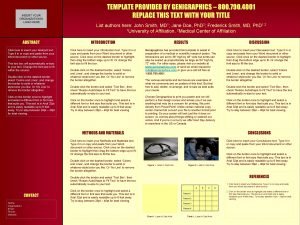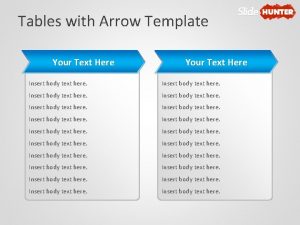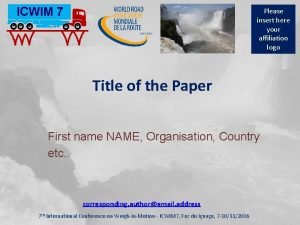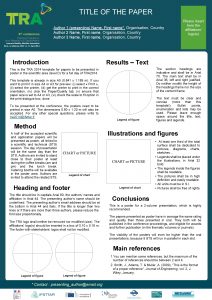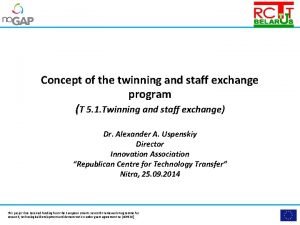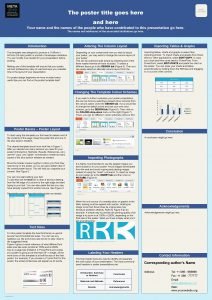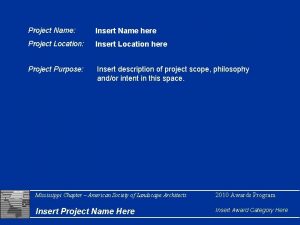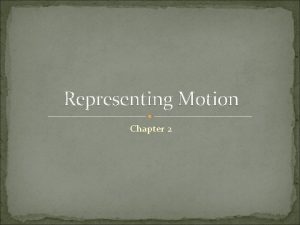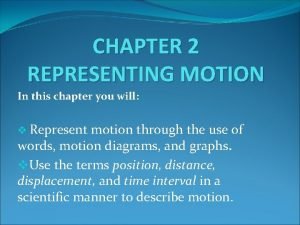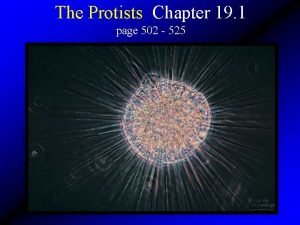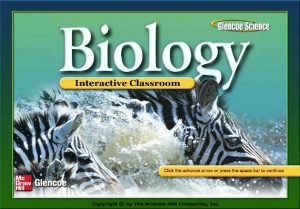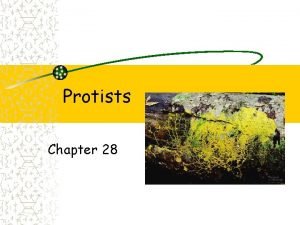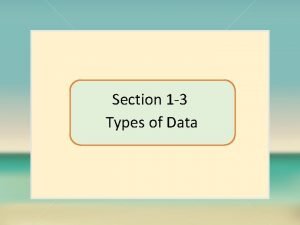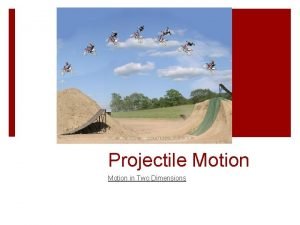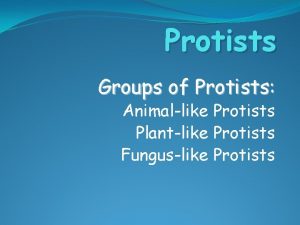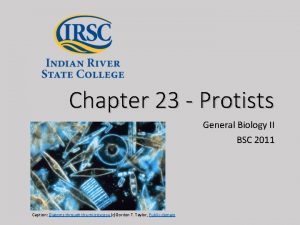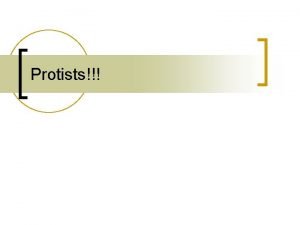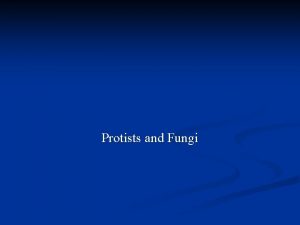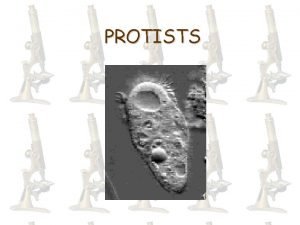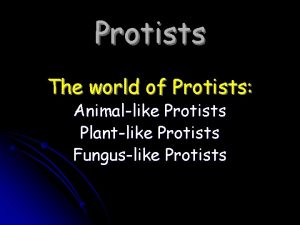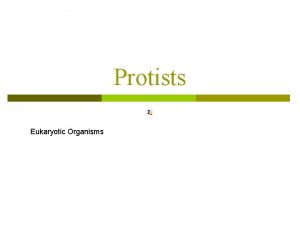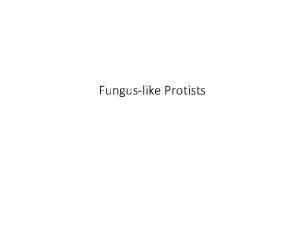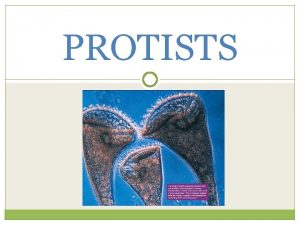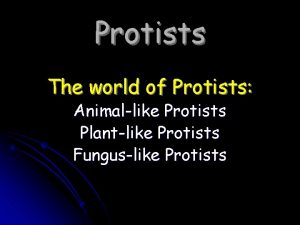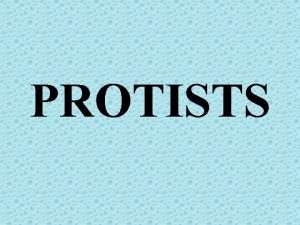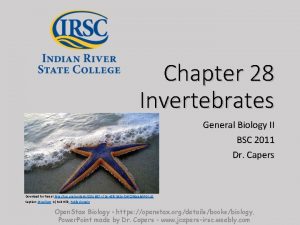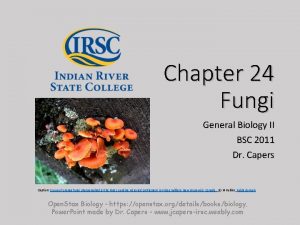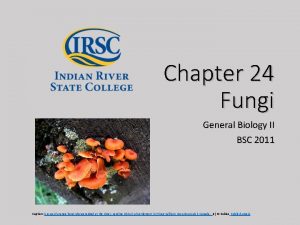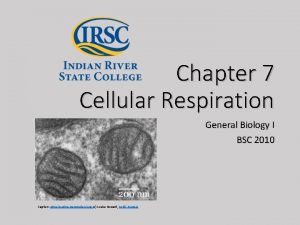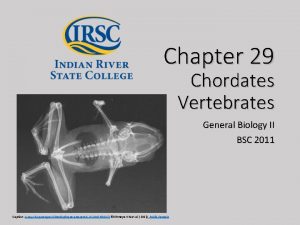Chapter 23 Protists Insert photo here representing chapter





































- Slides: 37

Chapter 23 - Protists Insert photo here representing chapter General Biology II BSC 2011 Dr. Capers Caption: Diatoms through the microscope (c)Gordon T. Taylor, Public domain Open. Stax Biology - https: //openstax. org/details/books/biology, Power. Point made by Dr. Capers - www. jcapers-irsc. weebly. com

By the end of this chapter you should be able to: • List the characteristics of eukaryotes. • Explain the endosymbiotic theory. • Describe the different characteristics of protists. • Describe the metabolic diversity of protists. • Describe the life cycle diversity of protists. • Describe representative protist organisms from each of the 6 supergroups of eukaryotes. • Describe the way protists play in the ecosystem.

• In the previous chapter, we discussed the prokaryotes. • From now on, we will be discussing the organisms composed of eukaryotic cells, those in Domain Eukarya. • Eukaryotic organisms that are not fungi, animals or plants are collectively called Protists • Formerly in Kingdom Protista

Characteristics of Eukaryotes • Nucleus • Mitochondria • Some extant eukaryotes have reduced or missing mitochondria but most have a typical mitochondria • Cytoskeleton • Eukaryotic cells are larger than prokaryotic cells, needs support structure • Flagella that look different than prokaryotic flagella • Linear chromosomes • Remember that prokaryotes have circular chromosome • Mitosis • In order to keep track of all the linear chromosomes, eukaryotes need the process of mitosis for division

Endosymbiosis and the Evolution of the Eukaryotes • Let’s review prokaryotic metabolism • Earth formed about 4. 5 billion years ago • Prokayotes arose ~3. 7 -3. 5 billion years ago • First prokaryotes used anaerobic respiration, fermentation • ~3. 5 billion years ago, some prokaryotes began to photosynthesize • Remember that a by-product of photosynthesis is O 2 • This allowed the evolution of aerobic respiration, which was able to generate much higher levels of ATP (which is needed if you are a complex eukaryote) • Eukaryotes arose ~2 – 2. 1 billion years ago

• Endosymbiotic Theory • States that one prokaryotic cell engulfed another prokaryotic cell, resulting in both being dependent on each other and the engulfed cell began to function as the mitochondria Download for free at http: //cnx. org/contents/185 cbf 87 -c 72 e-48 f 5 -b 51 e-f 14 f 21 b 5 eabd@10. 61

• Evidence for the endosymbiotic theory • Mitochondria and chloroplasts • Arise from division of existing mitochondria in the cell • This division process looks a lot like binary fission in prokaryotes • Most mitochondria are shaped like alpha-proteobacteria • Have a circular chromosome

• Modern science is shying away from the idea of traditional ranks such as “Kingdom” and “Phylum” • The field of molecular genetics shows that some protists are more closely related to animals, plants or fungi then they are to other protists • Therefore, they cannot be classified in the same Kingdom anymore

• Domain Eukarya is now divided into 6 main Super Groups • The protists that were once in Kingdom Protista are now spread over these super groups • We’ll go over those 6 groups in a bit

Protist Diversity • Protists are very diverse • “Protozoa” – heterotrophic protists • Some cause disease • “Algae” – autotrophic protists • Unicellular – phytoplankton • Multicellular – seaweed (not plants!) • Variety of habitats • • Most are aquatic (freshwater and marine) Damp soil Some are parasites that infect animals or plants A few are decomposers

Characteristics of Protists • Cell Structure Most protists are microscopic and unicellular There are multicellular forms Some live colonially Some are multi-nucleated that look like enormous blobs of slime • Some have animal-like cell membrane, some have plantlike cell wall • • • Some might be encased in silica-based shell

Characteristics of Protists • Metabolism • Some protists are autotrophs – photosynthesize • Some are heterotrophic • Some are mixotrophs – can be autotrophic or heterotrophic

Characteristics of Protists • Motility • Majority of protists have motility Download for free at http: //cnx. org/contents/185 cbf 87 -c 72 e-48 f 5 -b 51 e-f 14 f 21 b 5 eabd@10. 61

Characteristics of Protists • Life Cycles • Protists reproduce by a variety of different mechanisms: • Asexual reproduction • Binary fission • Budding • Shizongony – multiple nuclear divisions before division of the cell • Sexual reproduction • Some form cysts • Protective resting stage – resistant to temperature, p. H, etc • Some parasitic protists have complicated life cycles involving multiple hosts

Download for free at http: //cnx. org/contents/185 cbf 87 -c 72 e-48 f 5 -b 51 e-f 14 f 21 b 5 eabd@10. 61

Excavata • Characteristics of Excavata: • • Asymmetrical Single celled Feeding groove “excavated” on one side Includes autotrophs, heterotrophs (some parasites)

Excavata • Excavata • Diplomonads • Only have mitochondrial remnants • Includes intestinal parasite, Giardia lamblia • Forms cysts First picture: Caption: Giardia lamblia cyst. Iodine stain (c)CDC, Public domain Second picture: Caption: Giardia lamblia (G. intestinalis) imago and cystis (c) CDC/Alexander J. da Silva, Ph. D/Melanie Moser, Public domain Third picture: Caption: Giardia lamblia seen in a cytologic preparation (cytospin of formalin from small bowel biopsy of a patient with giardia) (c) Jerad M Gardner, MD, CC BY-SA 3. 0

Excavata • Parabasalids • Includes Trichomonas vaginalis First picture: Caption: Micrograph showing trichomonas on a Pap test (c)Nephron, CC BY-SA 3. 0 Second picture: Caption: Trichomoniasis: life cycle of Trichomonas vaginalis (c)CDC, Public domain

Excavata • Euglenozoans • Includes parasites, heterotrophs, autotrophs and mixotrophs • Euglena • Mixotroph, have primitive ocular organ called an eyespot guides them towards light sources • Trypanosoma • Parasite- transmitted by insects • Blood borne disease (causes diseased such as African Sleeping Sickness) First picture: Caption: Euglena sp. , a diagrammatic drawing (c) Alexei Kouprianov, CC BY-SA 3. 0 Second picture: Caption: Trypanosoma evansi protozoa (c)Alan R. Walker, CC BY-SA 3. 0

Chromalveolata • Alveolates • Presence of alveolus (membrane enclosed sac) under cell membrane, exact function unknown • Dinoflagellates • Apicomplexans • Ciliates • Stramenopiles • “hairy” flagellum • Diatoms • Brown algae • Oomycetes

Chromalveolata • Alveolates, Dinoflagellates • • Can be photosynthetic or heterotrophic Major part of the plankton Many exhibit bioluminescence Example: Ceratium First picture: Download for free at http: //cnx. org/contents/185 cbf 87 -c 72 e-48 f 5 -b 51 e-f 14 f 21 b 5 eabd@10. 61 Second picture: caption: Ceratium sp. (Dinophyta) (c) Keisotyo, CC BY-SA 3. 0

Chromalveolata • Aveolates, Apicomlexans • Example: Plasmodium (causes malaria) • Complex life cycle in the mosquito and human caption: Immature and mature trophozoites of the Plasmodium vivax parasite PHIL 2720 lores (c) CDC/ Dr. Mae Melvin, Public domain

Chromalveolata • Alveolates, Ciliates • Have cilia • Capture food particles in oral groove and then congregate food in food vacuole • Paramecium Download for free at http: //cnx. org/contents/185 cbf 87 -c 72 e-48 f 5 -b 51 e-f 14 f 21 b 5 eabd@10. 61

• Stentor • Vorticella First picture: Caption: Stentor coeruleus (c) Flupke 59, CC BY-SA 3. 0 Second picture: Caption: Stentor (c)Popular Science Monthly vol. 71, Public domain Third picture: Caption: Vorticella (c)Pearson Scott Foresman, Public domain

Chromalveolata • Stramenopiles, Diatoms • Unicellular photosynthetic protists • Part of the plankton, phytoplankton • Glassy cell wall made of silica dioxide First picture: Caption: Several species of freshwater diatoms (c)Damián H. Zanette, Public domain Second picture: Caption: Circle of diatoms on a slide (c)Wipeter, CC BY-SA 3. 0

Chromalveolata • Stramenopiles, Brown Algae • Macroscopic seaweed First picture: Caption: Sargassum weeds closeup (c)Islands in the Sea 2002, NOAA/OER, Public domain Second picture: Caption: Kelp forest Monterey (c)Stef Maruch, CC BY-SA 2. 0

Chromalveolata • Stramenopiles, Oomycetes • • • Once thought to be a fungus “egg fungus” Include many saprobes and parasites Saprobes appear as white and fluffy on dead organisms Includes pathogen responsible for Irish potato famine caption: Potato Blight effects (c)United States Department of Agriculture, Public domain

Rhizaria • Rhizaria include many of the amoebas (most have threadlike or needle like pseudopods) • Includes Radiolarians (part of the phytoplankton) First picture: Caption: Radiolaria varios (c) Luis Fernández García, CC BY-SA Spain Second picture: Caption: Haeckel Radiolarian detail (c) Ernst Haeckel, Public domain

Archaeplastida • Includes Red Algae, Green Algae and the Land Plants (Kingdom Plantae) • Red Algae caption: Red Algae on bleached coral (c) Johnmartindavies, CC BY-SA 3. 0

Archeaplastida • Green Algae • Charophytes – closest living relative to land plants • Common in wet habitats • Chlorophytes • Microscopic and macroscopic First picture: Caption: Mikrofoto. de-volvox (c)Frank Fox, CC BY-SA 3. 0 Germany Second picture: Caption: 3 x 2 millimeters of Spirogyra (c)Bob Blaylock, CC BY-SA 3. 0 Third picture: Caption: Meersalat-Ulva-lactuca (c) H. Krisp, CC BY-SA 3. 0

• The Archaeplastids also include the plants in Kingdom Plantae that we will discuss in a future chapter

Amoebozoa • Amoebozoans exhibit pseudopodia that are flat rather than hair-like found in Rhizarians • Amoeba Download for free at http: //cnx. org/contents/185 cbf 87 -c 72 e-48 f 5 -b 51 e-f 14 f 21 b 5 eabd@10. 61

• Plasmodial Slime Molds and Cellular Slime Molds • Video: https: //www. youtube. com/watch? v=K 8 HEDqo. TPgk

Amoebozoa • Plasmodial slime molds. Stream along as a plasmodium • Nonwalled, multinucleate mass of cytoplasm • Form called feeding phase • Ingests bacteria and other organic material • When food or moisture is scarce, organism forms sporangia, where spores are produced Physarum First picture: Caption: Physarum polycephalum plasmodium (c)frankenstoen, CC BY Second picture: Caption: Physarum psittacinum (c)Helen. Ginger, CC BY-SA 3. 0

• Cellular slime molds • Individual organisms behave as separate amoebas when food is abundant • Move through soil ingesting bacteria • When food is scarce, organisms aggregate to form a slug, “animal-like” • Slug differentiates into a sporocarp that will asexually produce spores caption: modification of work by Dr. Jonatha Gott and the Center for RNA Molecular Biology, Case Western Reserve University OR Download for free at http: //cnx. org/contents/185 cbf 87 -c 72 e-48 f 5 -b 51 e-f 14 f 21 b 5 eabd@10. 61

Opisthokonta • Single apical flagellum is present • This group includes animals, fungi and choanoflagellate protists • Choanoflagellates: • Live colonially • Believed to resemble ancestor to animals • Resemble choanocyte cells found in sponges First picture: Caption: Cronoflagelado 2 (c)Urutseg, CC BY-SA 3. 0 Second picture: Caption: Sphaeroeca-colony (c)Dhzanette, Public domain

Ecology of Protists • Phytoplankton – important primary producers • Feed large portion of ocean species • Some dinoflagellates have symbiotic relationship with corals • Some are human pathogens • Plasmodium – malaria • Trypanosoma – African sleeping sickness • Amoeba – some species can be parasitic • Some are plant pathogens • Can be responsible for taking out large amounts of crops • Some are important decomposers • Fossil Fuels • Large amounts of ancient blooms of plankton over time have been transformed to fossil fuels
 Insert photo here
Insert photo here Type name here
Type name here Numberblocks font
Numberblocks font Insert logo here
Insert logo here Insert logo here
Insert logo here Insert pic here
Insert pic here Voice brand name
Voice brand name Insert your text here
Insert your text here Insert logo here
Insert logo here Insert text here
Insert text here Please insert here
Please insert here Please insert here
Please insert here Name goes here
Name goes here Insert logo here
Insert logo here Insert picture here
Insert picture here Add your text here
Add your text here Insert logo here
Insert logo here Insert logo here
Insert logo here By name title
By name title Insert company logo here
Insert company logo here Insert your name here
Insert your name here Insert logo here
Insert logo here Presenter insert
Presenter insert Insert logo here
Insert logo here Photo goes here
Photo goes here Picture goes here
Picture goes here Chapter 2 assessment physics principles and problems
Chapter 2 assessment physics principles and problems Here i bow down here i bow down
Here i bow down here i bow down Representing motion
Representing motion Chapter 2 representing motion
Chapter 2 representing motion Sexual reproduction in paramecia is called _____.
Sexual reproduction in paramecia is called _____. Section 1 introduction to protists answer key
Section 1 introduction to protists answer key Chapter 28 protists
Chapter 28 protists Represented speech examples
Represented speech examples Statistic vs parameter example
Statistic vs parameter example Mark ardis
Mark ardis Representing comparing and ordering decimals
Representing comparing and ordering decimals Vector arrows representing the vx and vy
Vector arrows representing the vx and vy




